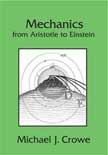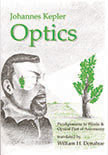Current Book List
Alphabetical by Author
This page lists books by original author and published author, editor or translator.
For more information about a specific book, including price and ordering information, click that book's cover or title.
Apollonius of Perga
Conics: Books I-IV
by Apollonius of Perga
Books I-III translated by R. Catesby Taliaferro
Book IV translated by Michael N. Fried
Diagrams by William H. Donahue
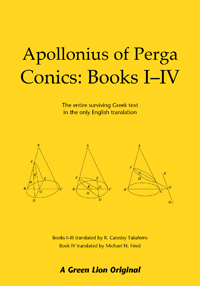 A combined edition of Conics Books I-III and Conics Book IV, previously available only as separate volumes.
A combined edition of Conics Books I-III and Conics Book IV, previously available only as separate volumes.
This is the only available English translation of the Greek text for these four books.
Aristotle
Aristotle's Metaphysics
translated by Joe Sachs
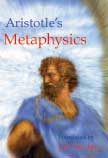 Joe Sachs has followed up his success with his translation of Aristotle's Physics with a new translation of Metaphysics. Sachs's translation brings distinguished new light onto this Aristotle's work, which is foundational to history of science, opening up Aristotle's original thought to readers by using Aristotle's everyday language rather than abstract Latinate words which distort his meaning.
Joe Sachs has followed up his success with his translation of Aristotle's Physics with a new translation of Metaphysics. Sachs's translation brings distinguished new light onto this Aristotle's work, which is foundational to history of science, opening up Aristotle's original thought to readers by using Aristotle's everyday language rather than abstract Latinate words which distort his meaning.
On the Soul and On Memory and Recollection
translated by Joe Sachs
 We continue Joe Sachs's new translations of Aristotle with On the Soul, a work that contains not only Aristotle's treatment of the psyche but also his theory of light and color. Again, Sachs's fresh and jargon-free approach cuts through presuppositions and prejudices that are associated with the idea of "soul." Includes Aristotle's work On Memory and Recollection.
We continue Joe Sachs's new translations of Aristotle with On the Soul, a work that contains not only Aristotle's treatment of the psyche but also his theory of light and color. Again, Sachs's fresh and jargon-free approach cuts through presuppositions and prejudices that are associated with the idea of "soul." Includes Aristotle's work On Memory and Recollection.
Crowe, Michael J.
Mechanics from Aristotle to Einstein
by Michael J. Crowe
Notre Dame professor Michael Crowe followis up his deservedly popular Theories of the World from Antiquity to the Copernican Revolution and Modern Theories of the Universe from Herschel to Hubble with this guided sourcebook on motion and its causes. The book presents substantial selections from the writings of Galileo, Newton, and Einstein, with additional selections from Aristotle, Oresme, Descartes, and Huygens. The book has extensive commentary aimed at guiding nonspecialist readers through the texts. At the same time, Crowe gives a "hands-on" account of the growth of mathematical physics, using only very simple algebra to re-state the less accessible earlier mathematics. Mechanics from Aristotle to Einstein is thus both a vivid introduction to the history of mechanics and a textbook in elementary mechanics.
Darwin, Charles
Selections from Darwin's The Origin of Species: The Shape of the Argument
by Nicholas Maistrellis
A Science Classics Module for Humanities Studies
A Green Cat Book
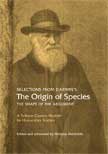 The substantial passages provided in this edition allow one to enjoy the precision and clarity of Darwin’s writing and the patient thoroughness of his reasoning. Step by step, layer by layer, detail by detail, like the most intricate detective story, he constructs his case.
The substantial passages provided in this edition allow one to enjoy the precision and clarity of Darwin’s writing and the patient thoroughness of his reasoning. Step by step, layer by layer, detail by detail, like the most intricate detective story, he constructs his case.
Densmore, Dana
Newton's Principia: The Central Argument
by Dana Densmore
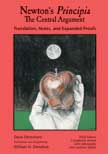 This guidebook by Dana Densmore with translations and diagrams by William H. Donahue makes the great adventure of Principia available not only to modern scholars of history of science but also to nonspecialist undergraduate students of humanities. It moves carefully from Newton's definitions and axioms, through the essential propositions, as Newton himself identified them, to the establishment of universal gravitation and elliptical orbits.
This guidebook by Dana Densmore with translations and diagrams by William H. Donahue makes the great adventure of Principia available not only to modern scholars of history of science but also to nonspecialist undergraduate students of humanities. It moves carefully from Newton's definitions and axioms, through the essential propositions, as Newton himself identified them, to the establishment of universal gravitation and elliptical orbits.
Now in its third edition, the guidebook presents Newton's original text (the selections newly translated for this edition), offers notes and questions for pondering, and then expands Newton's sketched proofs step by step. Following his original proofs exactly eliminates the common confusions and misinterpretations of what Newton assumed and what he proved in the course of the development of his great work.
Selections from Newton's Principia
by Dana Densmore
A Science Classics Module for Humanities Studies
A Green Cat Book
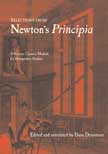 Newton’s new conception of the laws of the universe challenged centuries of received opinion and laid a new foundation for our “common sense” understanding of the physical world. If you have always wanted to know more about Newton’s achievement but thought it was the exclusive province of experts, this little book will guide you through the essentials of Newton’s argument in his own words and using only elementary mathematics.
Newton’s new conception of the laws of the universe challenged centuries of received opinion and laid a new foundation for our “common sense” understanding of the physical world. If you have always wanted to know more about Newton’s achievement but thought it was the exclusive province of experts, this little book will guide you through the essentials of Newton’s argument in his own words and using only elementary mathematics.
Descartes, René
Mechanics from Aristotle to Einstein
by Michael J. Crowe
Notre Dame professor Michael Crowe follows up his deservedly popular Theories of the World from Antiquity to the Copernican Revolution and Modern Theories of the Universe from Herschel to Hubble with a guided sourcebook on motion and its causes. The book presents substantial selections from the writings of Galileo, Newton, and Einstein, with additional selections from Aristotle, Oresme, Descartes, and Huygens. The book has extensive commentary aimed at guiding nonspecialist readers through the texts. At the same time, Crowe gives a "hands-on" account of the growth of mathematical physics, using only very simple algebra to re-state the less accessible earlier mathematics. Mechanics from Aristotle to Einstein is thus both a vivid introduction to the history of mechanics and a textbook in elementary mechanics.
Donahue, William H.
The Almagest: Introduction to the Mathematics of the Heavens
by Claudius Ptolemy
selections translated by Bruce M. Perry
edited with notes by William H. Donahue
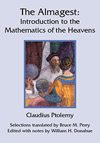 A new translation of selections of Ptolemy's Almagest. The book includes notes to assist a nonspecialist readership.
A new translation of selections of Ptolemy's Almagest. The book includes notes to assist a nonspecialist readership.
Designed as a text for use in courses, it contains extensive introductions to the celestial phenomena and to Ptolemy's world system, as well as preliminaries to the individual books of the Almagest. The selection includes Ptolemy's presentation of the form of the universe, the mathematical tools necessary to construct planetary theories, and the theories of the sun, Venus, Mars, together with an account of retrograde motion and the procedure for computing planetary positions for any date. This selection constitutes a lucid introduction to Ptolemy's extraordinarily powerful constructions and his amazingly sophisticated mathematical methods.
Astronomia Nova
by Johannes Kepler
translated by William H. Donahue
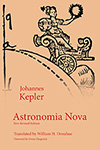 Second edition, completely revised, of the only English translation of Kepler's entire 1609 masterpiece. A work of astonishing originality, Astronomia Nova stands, with Copernicus's De Revolutionibus and Newton's Principia, as one of the founding texts of the scientific revolution. Kepler revolutionized astronomy by insisting that it be based upon physics rather than ideal geometrical models. Includes many new features, including a comprehensive index.
Second edition, completely revised, of the only English translation of Kepler's entire 1609 masterpiece. A work of astonishing originality, Astronomia Nova stands, with Copernicus's De Revolutionibus and Newton's Principia, as one of the founding texts of the scientific revolution. Kepler revolutionized astronomy by insisting that it be based upon physics rather than ideal geometrical models. Includes many new features, including a comprehensive index.
Conics: Books I-IV
by Apollonius of Perga
Books I-III translated by R. Catesby Taliaferro
Book IV translated by Michael N. Fried
Diagrams by William H. Donahue
 A combined edition of Conics Books I-III and Conics Book IV, previously available only as separate volumes.
A combined edition of Conics Books I-III and Conics Book IV, previously available only as separate volumes.
This is the only available English translation of the Greek text for these four books.
Optics
by Johannes Kepler
translated with diagrams by
William H. Donahue
The first complete translation of Kepler's Ad Vitellionem paralipomena, quibus astronomiae pars optica traditur (1604) by William H. Donahue, the translator of Kepler's New Astronomy. The Optics began as an attempt to give astronomical optics a solid foundation and soon transcended this narrow goal to become a complete reconstruction of the theory of light, the physiology of vision, and the mathematics of refraction.
Selections from Kepler's Astronomia Nova
by William H. Donahue
A Science Classics Module for Humanities Studies
A Green Cat Book
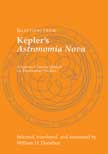 An annotated translation of selections from Kepler's greatest work. Much of the book is nontechnical in nature, discussing gravity, the earth's motion (in relation to both physics and scriptural interpretation), and the physical aspects of the planets' motions. An excellent, brief introduction to Kepler's thought.
An annotated translation of selections from Kepler's greatest work. Much of the book is nontechnical in nature, discussing gravity, the earth's motion (in relation to both physics and scriptural interpretation), and the physical aspects of the planets' motions. An excellent, brief introduction to Kepler's thought.
Euclid
The Bones
 A handy where-to-find-it pocket reference companion to Euclid's Elements, this has all of Euclid's propositions and diagrams without the proofs.
A handy where-to-find-it pocket reference companion to Euclid's Elements, this has all of Euclid's propositions and diagrams without the proofs.
Euclid's Elements
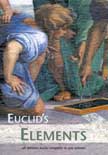 We have taken the classic Heath translation, given it a completely new layout with plenty of space and generous margins, and published it in an affordable but sturdy student edition in one volume, with minimal notes.
We have taken the classic Heath translation, given it a completely new layout with plenty of space and generous margins, and published it in an affordable but sturdy student edition in one volume, with minimal notes.
Euclid's Elements Book One with Questions for Discussion
Edited with Questions for Discussion by Dana Densmore
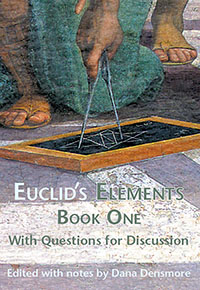 The opening book of Euclid's classic, for study of Euclid in the context of the humanities.
The opening book of Euclid's classic, for study of Euclid in the context of the humanities.
Faraday, Michael
Experimental Researches in Electricity
three deluxe volumes
by Michael Faraday
 Green Lion Press offers this monumental work in a handsome facsimile reprint of the three-volume first edition.
Green Lion Press offers this monumental work in a handsome facsimile reprint of the three-volume first edition.
Faraday's Experimental Researches in Electricity: Guide to a First Reading
by Michael Faraday
edited and with notes by Howard J. Fisher
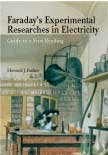 Howard Fisher guides the reader through Faraday's Experimental Researches in Electricity, displaying Faraday's experimental virtuosity and keen theoretical insight. Fisher's thoughtful selections and clear, helpful explanations of the instrumentation and elecromagnetic phenomena make this fascinating text accessible to those who lack time to find their way through the labyrinths of the original.
Howard Fisher guides the reader through Faraday's Experimental Researches in Electricity, displaying Faraday's experimental virtuosity and keen theoretical insight. Fisher's thoughtful selections and clear, helpful explanations of the instrumentation and elecromagnetic phenomena make this fascinating text accessible to those who lack time to find their way through the labyrinths of the original.
Faraday's Experimental Researches in Electricity: The First Series
by Michael Faraday
edited and with notes by Howard J. Fisher
A Science Classics Module for Humanities Studies
A Green Cat Book
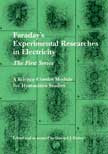 Faraday is also among the most accessible of writers, recounting his researches not in the abstract symbols of analytic mathematics but in vivid, lucid, English prose.
Faraday is also among the most accessible of writers, recounting his researches not in the abstract symbols of analytic mathematics but in vivid, lucid, English prose.
In this volume, Faraday boldly explores a new relation between magnetism and electricity. As we follow his narrative we can both witness and participate in his thinking, his questioning, and his insights.
Fisher, Howard J.
Faraday's Experimental Researches in Electricity: Guide to a First Reading
by Michael Faraday
edited and with notes by Howard J. Fisher
 Howard Fisher guides the reader through Faraday's Experimental Researches in Electricity, displaying Faraday's experimental virtuosity and keen theoretical insight. Fisher's thoughtful selections and clear, helpful explanations of the instrumentation and elecromagnetic phenomena make this fascinating text accessible to those who lack time to find their way through the labyrinths of the original.
Howard Fisher guides the reader through Faraday's Experimental Researches in Electricity, displaying Faraday's experimental virtuosity and keen theoretical insight. Fisher's thoughtful selections and clear, helpful explanations of the instrumentation and elecromagnetic phenomena make this fascinating text accessible to those who lack time to find their way through the labyrinths of the original.
Faraday's Experimental Researches in Electricity: The First Series
by Michael Faraday
edited and with notes by Howard J. Fisher
A Science Classics Module for Humanities Studies
A Green Cat Book
 Faraday is also among the most accessible of writers, recounting his researches not in the abstract symbols of analytic mathematics but in vivid, lucid, English prose.
Faraday is also among the most accessible of writers, recounting his researches not in the abstract symbols of analytic mathematics but in vivid, lucid, English prose.
In this volume, Faraday boldly explores a new relation between magnetism and electricity. As we follow his narrative we can both witness and participate in his thinking, his questioning, and his insights.
A Maxwellian Path to Maxwell's Equations: Chapters from Maxwell's Treatise on Electricity and Magnetism and Other Papers
by Howard J. Fisher
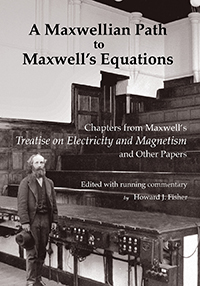 This compact book provides a kind of whirlwind tour of Maxwell's Treatise on Electricity and Magnetism, leading to a derivation of the expressions that later became known as "Maxwell's Equations." Far from a dry mathematical exercise, the presentation is fully in keeping with Maxwell's deepest insights and is expressed using his own words. For both students and more advanced scholars, it provides both a concise introduction to Maxwell's thought and a bridge to later physical theory, most notably Einstein's On the Electrodynamics of Moving Bodies (1905).
This compact book provides a kind of whirlwind tour of Maxwell's Treatise on Electricity and Magnetism, leading to a derivation of the expressions that later became known as "Maxwell's Equations." Far from a dry mathematical exercise, the presentation is fully in keeping with Maxwell's deepest insights and is expressed using his own words. For both students and more advanced scholars, it provides both a concise introduction to Maxwell's thought and a bridge to later physical theory, most notably Einstein's On the Electrodynamics of Moving Bodies (1905).
Maxwell's Treatise on Electricity and Magnetism: the Central Argument
by Howard J. Fisher
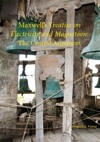 Maxwell's Treatise on Electricity and Magnetism brought about what Einstein called "the greatest change in the axiomatic basis of physics since Newton." But Maxwell's aim was never to construct an axiomatic theory. Instead, the Treatise presents an argument which, beginning with the most characteristic electrical and magnetic phenomena, and interpreting them as manifestations of continuous fields of electric and magnetic energy, culminates in Maxwell's theory of light as a wave motion within those fields.
Maxwell's Treatise on Electricity and Magnetism brought about what Einstein called "the greatest change in the axiomatic basis of physics since Newton." But Maxwell's aim was never to construct an axiomatic theory. Instead, the Treatise presents an argument which, beginning with the most characteristic electrical and magnetic phenomena, and interpreting them as manifestations of continuous fields of electric and magnetic energy, culminates in Maxwell's theory of light as a wave motion within those fields.
The argument of the Treatise is not straightforwardly demonstrative but is a dialectical one that can be challenging to discern among the many topics presented. This book undertakes to extract and expound the principal path of Maxwell's dialectical thinking.
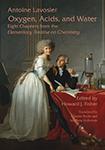 Oxygen, Acids, and Water: Eight Chapters from the Elementary Treatise on Chemistry
Oxygen, Acids, and Water: Eight Chapters from the Elementary Treatise on Chemistry
by Antoine Lavoisier
with Introduction and Notes by Howard J. Fisher
A Green Cat Book
Lavoisier shares with poets a deep concern for getting the words right. Of his Treatise, he writes, "while my sole intention was to perfect the language of chemistry, my work, in a manner I could not resist, imperceptibly transformed in my hands into an elementary treatise on chemistry" The result is both revolutionary and accessible.
Fried, Michael N.
Conics: Books I-IV
by Apollonius of Perga
Books I-III translated by R. Catesby Taliaferro
Book IV translated by Michael N. Fried
Diagrams by William H. Donahue
 A combined edition of Conics Books I-III and Conics Book IV, previously available only as separate volumes.
A combined edition of Conics Books I-III and Conics Book IV, previously available only as separate volumes.
This is the only available English translation of the Greek text for these four books.
Galileo
Mechanics from Aristotle to Einstein
by Michael J. Crowe
Notre Dame professor Michael Crowe follows up his deservedly popular Theories of the World from Antiquity to the Copernican Revolution and Modern Theories of the Universe from Herschel to Hubble with a guided sourcebook on motion and its causes. The book presents substantial selections from the writings of Galileo, Newton, and Einstein, with additional selections from Aristotle, Oresme, Descartes, and Huygens. The book has extensive commentary aimed at guiding nonspecialist readers through the texts. At the same time, Crowe gives a "hands-on" account of the growth of mathematical physics, using only very simple algebra to re-state the less accessible earlier mathematics. Mechanics from Aristotle to Einstein is thus both a vivid introduction to the history of mechanics and a textbook in elementary mechanics.
Huygens, Christiaan
Mechanics from Aristotle to Einstein
by Michael J. Crowe
Notre Dame professor Michael Crowe follows up his deservedly popular Theories of the World from Antiquity to the Copernican Revolution and Modern Theories of the Universe from Herschel to Hubble with a guided sourcebook on motion and its causes. The book presents substantial selections from the writings of Galileo, Newton, and Einstein, with additional selections from Aristotle, Oresme, Descartes, and Huygens. The book has extensive commentary aimed at guiding nonspecialist readers through the texts. At the same time, Crowe gives a "hands-on" account of the growth of mathematical physics, using only very simple algebra to re-state the less accessible earlier mathematics. Mechanics from Aristotle to Einstein is thus both a vivid introduction to the history of mechanics and a textbook in elementary mechanics.
Kepler, Johannes
Astronomia Nova
by Johannes Kepler
translated by William H. Donahue
 Second edition, completely revised, of the only English translation of Kepler's 1609 masterpiece. A work of astonishing originality, Astronomia Nova stands, with Copernicus's De Revolutionibus and Newton's Principia, as one of the founding texts of the scientific revolution. Kepler revolutionized astronomy by insisting that it be based upon physics rather than ideal geometrical models. Includes many new features, including a comprehensive index.
Second edition, completely revised, of the only English translation of Kepler's 1609 masterpiece. A work of astonishing originality, Astronomia Nova stands, with Copernicus's De Revolutionibus and Newton's Principia, as one of the founding texts of the scientific revolution. Kepler revolutionized astronomy by insisting that it be based upon physics rather than ideal geometrical models. Includes many new features, including a comprehensive index.
Optics
by Johannes Kepler
translated with diagrams by
William H. Donahue
The first complete translation of Kepler's Ad Vitellionem paralipomena, quibus astronomiae pars optica traditur (1604) by William H. Donahue, the translator of Kepler's New Astronomy. The Optics began as an attempt to give astronomical optics a solid foundation and soon transcended this narrow goal to become a complete reconstruction of the theory of light, the physiology of vision, and the mathematics of refraction.
Selections from Kepler's Astronomia Nova
by William H. Donahue
A Science Classics Module for Humanities Studies
A Green Cat Book
 An annotated translation of selections from Kepler's greatest work. Much of the book is nontechnical in nature, discussing gravity, the earth's motion (in relation to both physics and scriptural interpretation), and the physical aspects of the planets' motions. An excellent, brief introduction to Kepler's thought.
An annotated translation of selections from Kepler's greatest work. Much of the book is nontechnical in nature, discussing gravity, the earth's motion (in relation to both physics and scriptural interpretation), and the physical aspects of the planets' motions. An excellent, brief introduction to Kepler's thought.
Kollerstrom, Nicholas
Newton's Forgotten Lunar Theory: His Contribution to the Quest for Longitude
by Nicholas Kollerstrom
 Around the turn of the eighteenth century, one of the most pressing practical scientific problems was accurate prediction of the moon's position. Although Isaac Newton had hoped to solve this problem using the dynamic approach developed in Principia in 1687, he never succeeded in doing so. Instead, he reverted to an old-fashioned kinematic theory, using epicyclic motion. A terse summary of the theory was published in 1702 by David Gregory as part of his Astronomiae elementa.
Around the turn of the eighteenth century, one of the most pressing practical scientific problems was accurate prediction of the moon's position. Although Isaac Newton had hoped to solve this problem using the dynamic approach developed in Principia in 1687, he never succeeded in doing so. Instead, he reverted to an old-fashioned kinematic theory, using epicyclic motion. A terse summary of the theory was published in 1702 by David Gregory as part of his Astronomiae elementa.
The present work includes Newton's full text of Theory of the Moon's Motion with annotations explaining terms and relating the text to Kollerstrom's analysis. In this detailed study, Kollerstrom solves the enigma of Newton's "forgotten" lunar theory. He ascertains, for the first time ever, just what Newton's theory did and did not achieve.
Lavoisier, Antoine
 Oxygen, Acids, and Water: Eight Chapters from the Elementary Treatise on Chemistry
Oxygen, Acids, and Water: Eight Chapters from the Elementary Treatise on Chemistry
by Antoine Lavoisier
with Introduction and Notes by Howard J. Fisher
A Green Cat Book
Lavoisier shares with poets a deep concern for getting the words right. Of his Treatise, he writes, "while my sole intention was to perfect the language of chemistry, my work, in a manner I could not resist, imperceptibly transformed in my hands into an elementary treatise on chemistry" The result is both revolutionary and accessible.
A New Foundation for Chemistry: Lavoisier's Elementary Treatise on Chemistry, Preliminary Discourse and Part One
Translated from the 1789 edition by Chester Burke and Matthew Holtzman
Running commentary by Howard J. Fisher
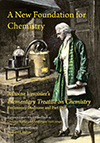 Here is a wonderful rarity: a revolutionary scientific work that is at the same time quite accessible and beautifully and clearly written. Following Condillac's maxim that "the art of reasoning is, at bottom, nothing else but a well-constructed language," Lavoisier creates a new system of chemical nomenclature and uses it to build a rational structure that leads to a complete revision of our understanding of chemical action. Howard Fisher's commentary complements Lavoisier's treatise beautifully, clarifying obscure terms and explaining laboratory operations.
Here is a wonderful rarity: a revolutionary scientific work that is at the same time quite accessible and beautifully and clearly written. Following Condillac's maxim that "the art of reasoning is, at bottom, nothing else but a well-constructed language," Lavoisier creates a new system of chemical nomenclature and uses it to build a rational structure that leads to a complete revision of our understanding of chemical action. Howard Fisher's commentary complements Lavoisier's treatise beautifully, clarifying obscure terms and explaining laboratory operations.
Maistrellis, Nicholas
Selections from Darwin's The Origin of Species: The Shape of the Argument
by Nicholas Maistrellis
A Science Classics Module for Humanities Studies
A Green Cat Book
 The substantial passages provided in this edition allow one to enjoy the precision and clarity of Darwin’s writing and the patient thoroughness of his reasoning. Step by step, layer by layer, detail by detail, like the most intricate detective story, he constructs his case.
The substantial passages provided in this edition allow one to enjoy the precision and clarity of Darwin’s writing and the patient thoroughness of his reasoning. Step by step, layer by layer, detail by detail, like the most intricate detective story, he constructs his case.
Marx, Karl
Newton, Maxwell, Marx: Spirit, Freedom, and the Scientific Vision
by Thomas K. Simpson
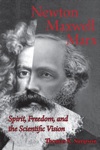 In these pages, we meet Isaac Newton, James Clerk Maxwell, and Karl Marx as we have never seen them before, as champions of a scientific vision that leads to intellectual freedom and human emancipation. We see Newton, the last of the alchemists, creating a visionary physics that was intended as a direct refutation of the dead mechanism of Cartesian philosophy. We see Maxwell striving to free the human intellect from the dogmatism of the "Newtonian" physics of his day, the champion of a new democratic science as exemplified by the work of Michael Faraday, a largely unschooled commoner. We are astonished to meet Marx, the ultimate libertarian, envisioning "a society in which the full and free development of every individual forms the ruling principle," a society that could be attained through a rational understanding deliberately constructed to emulate Newton's approach to physics.
In these pages, we meet Isaac Newton, James Clerk Maxwell, and Karl Marx as we have never seen them before, as champions of a scientific vision that leads to intellectual freedom and human emancipation. We see Newton, the last of the alchemists, creating a visionary physics that was intended as a direct refutation of the dead mechanism of Cartesian philosophy. We see Maxwell striving to free the human intellect from the dogmatism of the "Newtonian" physics of his day, the champion of a new democratic science as exemplified by the work of Michael Faraday, a largely unschooled commoner. We are astonished to meet Marx, the ultimate libertarian, envisioning "a society in which the full and free development of every individual forms the ruling principle," a society that could be attained through a rational understanding deliberately constructed to emulate Newton's approach to physics.
Maxwell, James Clerk
Figures of Thought: A Literary Appreciation of Maxwell's Treatise on Electricity and Magnetism
by Thomas K. Simpson
In this incisive work, Thomas Simpson shows that not only is a literary reading of James Clerk Maxwell's Treatise on Electricity and Magnetism possible, but that such a reading brings us closer to Maxwell's underlying thought, revealing purposes that reach far beyond the equations of electromagnetism.
Maxwell's Mathematical Rhetoric: Rethinking the Treatise on Electricity and Magnetism
by Thomas K. Simpson
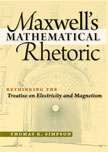 Green Lion Press is delighted to issue as a fine volume Simpson's classic work, which has been circulating underground for decades as photocopied typescript. It is the first major study of Maxwell's Treatise to take seriously the way Maxwell's presents his arguments. This is the original full treatment, to which Simpson's Figures of Thought provides an enticing introduction.
Green Lion Press is delighted to issue as a fine volume Simpson's classic work, which has been circulating underground for decades as photocopied typescript. It is the first major study of Maxwell's Treatise to take seriously the way Maxwell's presents his arguments. This is the original full treatment, to which Simpson's Figures of Thought provides an enticing introduction.
A Maxwellian Path to Maxwell's Equations: Chapters from Maxwell's Treatise on Electricity and Magnetism and Other Papers
by Howard J. Fisher
 This compact book provides a kind of whirlwind tour of Maxwell's Treatise on Electricity and Magnetism, leading to a derivation of the expressions that later became known as "Maxwell's Equations." Far from a dry mathematical exercise, the presentation is fully in keeping with Maxwell's deepest insights and is expressed using his own words. For both students and more advanced scholars, it provides both a concise introduction to Maxwell's thought and a bridge to later physical theory, most notably Einstein's On the Electrodynamics of Moving Bodies (1905).
This compact book provides a kind of whirlwind tour of Maxwell's Treatise on Electricity and Magnetism, leading to a derivation of the expressions that later became known as "Maxwell's Equations." Far from a dry mathematical exercise, the presentation is fully in keeping with Maxwell's deepest insights and is expressed using his own words. For both students and more advanced scholars, it provides both a concise introduction to Maxwell's thought and a bridge to later physical theory, most notably Einstein's On the Electrodynamics of Moving Bodies (1905).
Maxwell's Treatise on Electricity and Magnetism: the Central Argument
by Howard J. Fisher
 Maxwell's Treatise on Electricity and Magnetism brought about what Einstein called "the greatest change in the axiomatic basis of physics since Newton." But Maxwell's aim was never to construct an axiomatic theory. Instead, the Treatise presents an argument which, beginning with the most characteristic electrical and magnetic phenomena, and interpreting them as manifestations of continuous fields of electric and magnetic energy, culminates in Maxwell's theory of light as a wave motion within those fields.
Maxwell's Treatise on Electricity and Magnetism brought about what Einstein called "the greatest change in the axiomatic basis of physics since Newton." But Maxwell's aim was never to construct an axiomatic theory. Instead, the Treatise presents an argument which, beginning with the most characteristic electrical and magnetic phenomena, and interpreting them as manifestations of continuous fields of electric and magnetic energy, culminates in Maxwell's theory of light as a wave motion within those fields.
The argument of the Treatise is not straightforwardly demonstrative but is a dialectical one that can be challenging to discern among the many topics presented. This book undertakes to extract and expound the principal path of Maxwell's dialectical thinking.
Newton, Maxwell, Marx: Spirit, Freedom, and the Scientific Vision
by Thomas K. Simpson
 In these pages, we meet Isaac Newton, James Clerk Maxwell, and Karl Marx as we have never seen them before, as champions of a scientific vision that leads to intellectual freedom and human emancipation. We see Newton, the last of the alchemists, creating a visionary physics that was intended as a direct refutation of the dead mechanism of Cartesian philosophy. We see Maxwell striving to free the human intellect from the dogmatism of the "Newtonian" physics of his day, the champion of a new democratic science as exemplified by the work of Michael Faraday, a largely unschooled commoner. We are astonished to meet Marx, the ultimate libertarian, envisioning "a society in which the full and free development of every individual forms the ruling principle," a society that could be attained through a rational understanding deliberately constructed to emulate Newton's approach to physics.
In these pages, we meet Isaac Newton, James Clerk Maxwell, and Karl Marx as we have never seen them before, as champions of a scientific vision that leads to intellectual freedom and human emancipation. We see Newton, the last of the alchemists, creating a visionary physics that was intended as a direct refutation of the dead mechanism of Cartesian philosophy. We see Maxwell striving to free the human intellect from the dogmatism of the "Newtonian" physics of his day, the champion of a new democratic science as exemplified by the work of Michael Faraday, a largely unschooled commoner. We are astonished to meet Marx, the ultimate libertarian, envisioning "a society in which the full and free development of every individual forms the ruling principle," a society that could be attained through a rational understanding deliberately constructed to emulate Newton's approach to physics.
Newton, Isaac
Mechanics from Aristotle to Einstein
by Michael J. Crowe
Notre Dame professor Michael Crowe follows up his deservedly popular Theories of the World from Antiquity to the Copernican Revolution and Modern Theories of the Universe from Herschel to Hubble with a guided sourcebook on motion and its causes. The book presents substantial selections from the writings of Galileo, Newton, and Einstein, with additional selections from Aristotle, Oresme, Descartes, and Huygens. The book has extensive commentary aimed at guiding nonspecialist readers through the texts. At the same time, Crowe gives a "hands-on" account of the growth of mathematical physics, using only very simple algebra to re-state the less accessible earlier mathematics. Mechanics from Aristotle to Einstein is thus both a vivid introduction to the history of mechanics and a textbook in elementary mechanics.
Newton, Maxwell, Marx: Spirit, Freedom, and the Scientific Vision
by Thomas K. Simpson
 In these pages, we meet Isaac Newton, James Clerk Maxwell, and Karl Marx as we have never seen them before, as champions of a scientific vision that leads to intellectual freedom and human emancipation. We see Newton, the last of the alchemists, creating a visionary physics that was intended as a direct refutation of the dead mechanism of Cartesian philosophy. We see Maxwell striving to free the human intellect from the dogmatism of the "Newtonian" physics of his day, the champion of a new democratic science as exemplified by the work of Michael Faraday, a largely unschooled commoner. We are astonished to meet Marx, the ultimate libertarian, envisioning "a society in which the full and free development of every individual forms the ruling principle," a society that could be attained through a rational understanding deliberately constructed to emulate Newton's approach to physics.
In these pages, we meet Isaac Newton, James Clerk Maxwell, and Karl Marx as we have never seen them before, as champions of a scientific vision that leads to intellectual freedom and human emancipation. We see Newton, the last of the alchemists, creating a visionary physics that was intended as a direct refutation of the dead mechanism of Cartesian philosophy. We see Maxwell striving to free the human intellect from the dogmatism of the "Newtonian" physics of his day, the champion of a new democratic science as exemplified by the work of Michael Faraday, a largely unschooled commoner. We are astonished to meet Marx, the ultimate libertarian, envisioning "a society in which the full and free development of every individual forms the ruling principle," a society that could be attained through a rational understanding deliberately constructed to emulate Newton's approach to physics.
Newton's Forgotten Lunar Theory: His Contribution to the Quest for Longitude
by Nicholas Kollerstrom
 Around the turn of the eighteenth century, one of the most pressing practical scientific problems was accurate prediction of the moon's position. Although Isaac Newton had hoped to solve this problem using the dynamic approach developed in Principia in 1687, he never succeeded in doing so. Instead, he reverted to an old-fashioned kinematic theory, using epicyclic motion. A terse summary of the theory was published in 1702 by David Gregory as part of his Astronomiae elementa.
Around the turn of the eighteenth century, one of the most pressing practical scientific problems was accurate prediction of the moon's position. Although Isaac Newton had hoped to solve this problem using the dynamic approach developed in Principia in 1687, he never succeeded in doing so. Instead, he reverted to an old-fashioned kinematic theory, using epicyclic motion. A terse summary of the theory was published in 1702 by David Gregory as part of his Astronomiae elementa.
The present work includes Newton's full text of Theory of the Moon's Motion with annotations explaining terms and relating the text to Kollerstrom's analysis. In this detailed study, Kollerstrom solves the enigma of Newton's "forgotten" lunar theory. He ascertains, for the first time ever, just what Newton's theory did and did not achieve.
Newton's Principia: The Central Argument
by Dana Densmore
 This guidebook by Dana Densmore with translations and diagrams by William H. Donahue makes the great adventure of Principia available not only to modern scholars of history of science but also to nonspecialist undergraduate students of humanities. It moves carefully from Newton's definitions and axioms, through the essential propositions, as Newton himself identified them, to the establishment of universal gravitation and elliptical orbits.
This guidebook by Dana Densmore with translations and diagrams by William H. Donahue makes the great adventure of Principia available not only to modern scholars of history of science but also to nonspecialist undergraduate students of humanities. It moves carefully from Newton's definitions and axioms, through the essential propositions, as Newton himself identified them, to the establishment of universal gravitation and elliptical orbits.
Now in its third edition, the guidebook presents Newton's original text (the selections newly translated for this edition), offers notes and questions for pondering, and then expands Newton's sketched proofs step by step. Following his original proofs exactly eliminates the common confusions and misinterpretations of what Newton assumed and what he proved in the course of the development of his great work.
Selections from Newton's Principia
by Dana Densmore
A Science Classics Module for Humanities Studies
A Green Cat Book
 Newton’s new conception of the laws of the universe challenged centuries of received opinion and laid a new foundation for our “common sense” understanding of the physical world. If you have always wanted to know more about Newton’s achievement but thought it was the exclusive province of experts, this little book will guide you through the essentials of Newton’s argument in his own words and using only elementary mathematics.
Newton’s new conception of the laws of the universe challenged centuries of received opinion and laid a new foundation for our “common sense” understanding of the physical world. If you have always wanted to know more about Newton’s achievement but thought it was the exclusive province of experts, this little book will guide you through the essentials of Newton’s argument in his own words and using only elementary mathematics.
Perry, Bruce M.
The Almagest: Introduction to the Mathematics of the Heavens
by Claudius Ptolemy
selections translated by Bruce M. Perry
edited with notes by William H. Donahue
 A new translation of selections of Ptolemy's Almagest for a Ptolemy reader. The book includes notes to assist a nonspecialist readership.
A new translation of selections of Ptolemy's Almagest for a Ptolemy reader. The book includes notes to assist a nonspecialist readership.
Designed as a text for use in courses, it contains extensive introductions to the celestial phenomena and to Ptolemy's world system, as well as preliminaries to the individual books of the Almagest. The selection includes Ptolemy's presentation of the form of the universe, the mathematical tools necessary to construct planetary theories, and the theories of the sun, Venus, Mars, together with an account of retrograde motion and the procedure for computing planetary positions for any date. This selection constitutes a lucid introduction to Ptolemy's extraordinarily powerful constructions and his amazingly sophisticated mathematical methods.
Ptolemy, Claudius
The Almagest: Introduction to the Mathematics of the Heavens
by Claudius Ptolemy
selections translated by Bruce M. Perry
edited with notes by William H. Donahue
 A new translation of selections of Ptolemy's Almagest for a Ptolemy reader. The book includes notes to assist a nonspecialist readership.
A new translation of selections of Ptolemy's Almagest for a Ptolemy reader. The book includes notes to assist a nonspecialist readership.
Designed as a text for use in courses, it contains extensive introductions to the celestial phenomena and to Ptolemy's world system, as well as preliminaries to the individual books of the Almagest. The selection includes Ptolemy's presentation of the form of the universe, the mathematical tools necessary to construct planetary theories, and the theories of the sun, Venus, Mars, together with an account of retrograde motion and the procedure for computing planetary positions for any date. This selection constitutes a lucid introduction to Ptolemy's extraordinarily powerful constructions and his amazingly sophisticated mathematical methods.
Sachs, Joe
Aristotle's Metaphysics
translated by Joe Sachs
 Joe Sachs has followed up his success with his translation of Aristotle's Physics with a new translation of Metaphysics. Sachs's translation brings distinguished new light onto this Aristotle's work, which is foundational to history of science, opening up Aristotle's original thought to readers by using Aristotle's everyday language rather than abstract Latinate words which distort his meaning.
Joe Sachs has followed up his success with his translation of Aristotle's Physics with a new translation of Metaphysics. Sachs's translation brings distinguished new light onto this Aristotle's work, which is foundational to history of science, opening up Aristotle's original thought to readers by using Aristotle's everyday language rather than abstract Latinate words which distort his meaning.
On the Soul and On Memory and Recollection
by Aristotle
translated by
Joe Sachs
 We continue Joe Sachs's new translations of Aristotle with On the Soul, a work that contains not only Aristotle's treatment of the psyche but also his theory of light and color. Again, Sachs's fresh and jargon-free approach cuts through presuppositions and prejudices that are associated with the idea of "soul." Includes Aristotle's work On Memory and Recollection.
We continue Joe Sachs's new translations of Aristotle with On the Soul, a work that contains not only Aristotle's treatment of the psyche but also his theory of light and color. Again, Sachs's fresh and jargon-free approach cuts through presuppositions and prejudices that are associated with the idea of "soul." Includes Aristotle's work On Memory and Recollection.
Simpson, Thomas K.
Figures of Thought: A Literary Appreciation of Maxwell's Treatise on Electricity and Magnetism
by Thomas K. Simpson
In this incisive work, Thomas Simpson shows that not only is a literary reading of James Clerk Maxwell's Treatise on Electricity and Magnetism possible, but that such a reading brings us closer to Maxwell's underlying thought, revealing purposes that reach far beyond the equations of electromagnetism.
Maxwell's Mathematical Rhetoric: Rethinking the Treatise on Electricity and Magnetism
by Thomas K. Simpson
 Green Lion Press is delighted to issue as a fine volume Simpson's classic work, which has been circulating underground for decades as photocopied typescript. It is the first major study of Maxwell's Treatise to take seriously the way Maxwell's presents his arguments. This is the original full treatment, to which Simpson's Figures of Thought provides an enticing introduction.
Green Lion Press is delighted to issue as a fine volume Simpson's classic work, which has been circulating underground for decades as photocopied typescript. It is the first major study of Maxwell's Treatise to take seriously the way Maxwell's presents his arguments. This is the original full treatment, to which Simpson's Figures of Thought provides an enticing introduction.
Newton, Maxwell, Marx: Spirit, Freedom, and the Scientific Vision
by Thomas K. Simpson
 In these pages, we meet Isaac Newton, James Clerk Maxwell, and Karl Marx as we have never seen them before, as champions of a scientific vision that leads to intellectual freedom and human emancipation. We see Newton, the last of the alchemists, creating a visionary physics that was intended as a direct refutation of the dead mechanism of Cartesian philosophy. We see Maxwell striving to free the human intellect from the dogmatism of the "Newtonian" physics of his day, the champion of a new democratic science as exemplified by the work of Michael Faraday, a largely unschooled commoner. We are astonished to meet Marx, the ultimate libertarian, envisioning "a society in which the full and free development of every individual forms the ruling principle," a society that could be attained through a rational understanding deliberately constructed to emulate Newton's approach to physics.
In these pages, we meet Isaac Newton, James Clerk Maxwell, and Karl Marx as we have never seen them before, as champions of a scientific vision that leads to intellectual freedom and human emancipation. We see Newton, the last of the alchemists, creating a visionary physics that was intended as a direct refutation of the dead mechanism of Cartesian philosophy. We see Maxwell striving to free the human intellect from the dogmatism of the "Newtonian" physics of his day, the champion of a new democratic science as exemplified by the work of Michael Faraday, a largely unschooled commoner. We are astonished to meet Marx, the ultimate libertarian, envisioning "a society in which the full and free development of every individual forms the ruling principle," a society that could be attained through a rational understanding deliberately constructed to emulate Newton's approach to physics.
Taliaferro, R. Catesby
Conics: Books I-IV
by Apollonius of Perga
Books I-III translated by R. Catesby Taliaferro
Book IV translated by Michael N. Fried
Diagrams by William H. Donahue
 A combined edition of Conics Books I-III and Conics Book IV, previously available only as separate volumes.
A combined edition of Conics Books I-III and Conics Book IV, previously available only as separate volumes.
This is the only available English translation of the Greek text for these four books.

